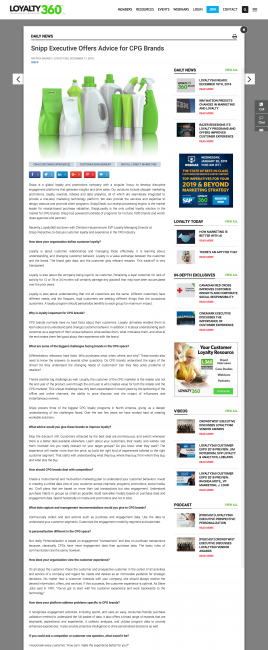Snipp Executive Offers Advice for CPG Brands
Recently, Loyalty360 sat down with Christian Hausammann EVP Loyalty Managing Director at
Snipp Interactive, to discuss customer loyalty and experience in the CPG industry.
How does your organization define customer loyalty?
Loyalty is about customer relationships and managing these effectively. It is learning about, understanding, and changing customer behavior. Loyalty is a value exchange between the customer and the brand. The brand gets data, and the customer gets relevant rewards. This trade-off is very transparent.
Loyalty is also about the company being loyal to its customer. Penalizing a loyal customer for lack of activity for 12 or 18 or 24 months will certainly damage any goodwill that may have been accumulated over the prior years.
Loyalty is also about understanding that not all customers are the same. Different customers have different needs, and the frequent, loyal customers are seeking different things than the occasional customers. A loyalty program should personalize benefits to each group for maximum impact.
Why is loyalty important for CPG brands?
CPG brands normally have no hard facts about their customers. Loyalty ultimately enables them to learn about and understand (and change) customer behavior. In addition, it is about understanding each customer as a segment of their unique behavior, what excites them, what motivates them, and what at the end makes them feel good about their experience with the brand.
What are some of the biggest challenges facing brands in the CPG space?
Differentiation, relevance, hard facts. Who purchases what, when, where, and why? These brands also need to know the answers to several other questions. Do CPD brands understand the signs of the times? Do they understand the changing needs of customers? Can they help solve problems of retailers?
There’s another big challenge as well. Usually, the customer of the CPG marketer is the retailer and not the end user of the product, even though the end user is who creates value for both the retailer and the CPG marketer. This unique challenge has only been exacerbated in recent years by the splintering of the offline and online channels, the ability to price discover, and the impact of influencers and instantaneous reviews.
Snipp powers three of the biggest CPG loyalty programs in North America, giving us a deeper understanding of the challenges faced. Over the last few years we have worked hard at creating workable solutions.
What advice would you give these brands to improve loyalty?
Stop the discount mill. Customers attracted by the best deal are promiscuous, and switch whenever there is a better deal available elsewhere. Learn about your customers, their needs, and wishes. Get them involved! Are you really relevant for your target groups? Do you know what they want? The experience will matter more than the price, so build the right kind of experiences tailored to the right customer segment. That starts with understanding what they buy, where they buy, from whom they buy, and what else the buy.
How should CPG brands deal with competition?
Create a multi-channel and multi-action marketing plan to understand your customer behaviors. Invest in creating a unified data view of your customer across channels, programs, promotions, social media, etc. Craft plans that are based on more than just transactions but also engagement. Understand purchase habits in groups as small as possible. Build look-alike models based on purchase data and engagement data. Spend holistically on media and promotions and not in silos.
What data capture and management recommendations would you give to CPG brands?
Continuously collect and test actions such as purchase and engagement data. Use the data to understand your customer segments. Customize the engagement model by segment and automate.
Is personalization different in the CPG space?
Not really. Personalization is based on engagement “transactions” and less on purchase transactions because, classically, CPGs have more engagement data than purchase data. The basic rules of communication are the same, however.
How does your organization view the customer experience?
It’s all about the customer. Place the customer and prospective customer in the center of all activities and actions of a company and regard her needs and desires as an immovable yardstick for strategic decisions. No matter how a customer interacts with your company, she should always receive the desired information, offers, and services. If this succeeds, the customer experience is optimal. As Steve Jobs said in 1997, “You’ve got to start with the customer experience and work backwards to the technology.”
How does your platform address problems specific to CPG brands?
It recognizes engagement activities, including spend, and uses an easy, consumer-friendly purchase validation method to understand the full basket of data. It also offers a broad range of rewards that are attainable, aspirational, and experiential. It collects, analyzes, and utilizes program data to provide enhanced experiences. It also provide proactive intelligence to drive personalized decisions as well.
If you could ask a competitor or customer one question, what would it be?
I would ask every customer, “How can I make the experience better for you?”



